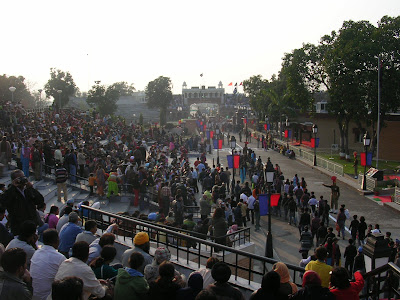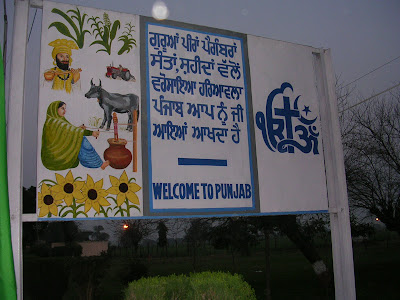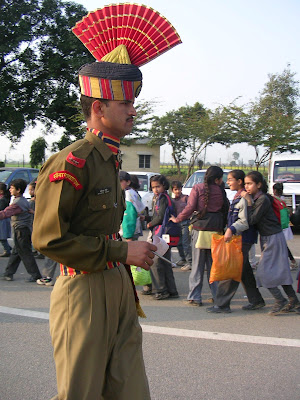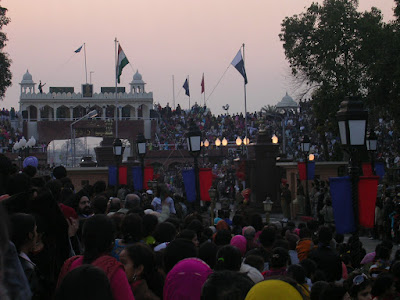The Wagah Border
Loud cheering. Clearly partisan fans wearing team colors waving flags and banners. Opposing teams facing off. Loud music supporting the home team. Cheerleaders! But, for all the comparisons I could make with a football game, this was definitely not a football game.
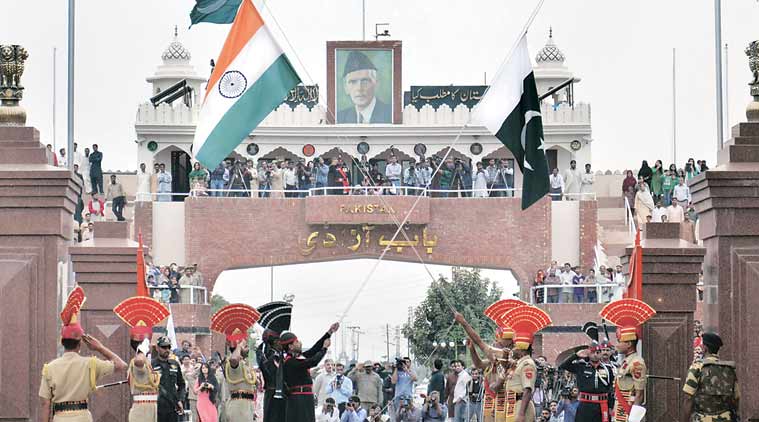
I am told that it will only get hotter. Its only the beginning of April and midday temperatures are already hovering in the low 100s. For those without A/Cs the only respite is the (comparatively) cooler evenings which as of now are at least a tolerable 85 degrees. I think back to three months ago: back in Washington I would have though 85 degrees to be far from tolerable. With the rising heat comes an enervating lethargy, but with no desire to do anything outside I find that I finally have a bit of time to reflect on the past few months and to catch up on writing…
As I mentioned in the previous entry, one of the more unique experiences so far has been my visit to the Wagah border, the India-Pakistan border some 30 km west of Amritsar in the northern state of Punjab.
I closed my eyes. I had closed them just a moment before while thinking to myself that the spectacle before me couldn’t possibly be real. While they were closed, I could easily imagine myself opening my eyes and finding myself in a football stadium: cheering, but clearly partisan fans wearing team colors waving flags and banners; opposing teams facing off; loud music supporting the ‘home team’; and cheerleaders!
I reopened my eyes; for all the comparisons I could make with a football game, this was definitely not a football game. I was sitting in a grandstand on the side of a road with at least 1500 other people. Across the road was a low rise building almost like a ranch style house, the first structure somebody from Pakistan would meet upon crossing the border into India. This border itself is marked by a large gate and lies to the left along the road about 30 meters from the building if you’re looking down from the grandstand.
The gate had an Indian flag imprinted upon it and on its left side there rose the tricolour itself. On the other side of the gate lay Pakistan; and appropriately enough given the similarities between India and Pakistan, there was an exact mirror image of this side: another gate, through which the same road continued, another grandstand another building. Indeed even the states on either side of the border had the same name: Punjab. A state and people spanning two countries since 1947. Partition and independence was here tangibly manifest. Yet the hostility and violence that marked the splitting of the Punjab only sixty years ago occurs now only in caricature, a theatrical performance: art imitating life. Surely, this is an improvement, a sign of better times. You could almost forget that these two nuclear powers were at a precarious standoff only a few years ago. Almost…
We had come to observe the border closing ceremony that takes place in the evening each night. It’s a military ceremony and occurs on both sides, though there didn’t seem to be much coordination between the ceremonies on either side of the gate. My friends and I flowed into the grandstand with the rest of the crowd. They were mostly families that had come to Amristar on vacation. They were boisterously nationalistic, waving little Indian flags.
Sitting down, I first noticed the music. Loud music. Songs proclaiming the virtues of India, its wonders, its greatness, and its unquestioned superiority. In between songs, there would be a pause, a short one, but long enough for us to hear the music from the other side. Though we couldn’t hear the words, there seemed to be little doubt what they were singing about.
Every so often the singing would be punctuated by chanting in the crowd. Someone would begin shouting hindi phrases like, “Bharat Mata ki…” (To Mother India…”) and the crowd would respond loudly in unison: “Jai” (Victory). There were two other phrases that were acceptable (it seems that they had had issues in the past with people yelling derisory phrases toward Pakistan): Hindustan Zindabad (Long Live India), and Vande Mataram (Hail to the Motherland).
As I watched the soldiers getting ready for the ceremony in front of the building, I heard similar chanting on the other side. Looking around, I realized that the chanting wasn’t as random as I had first thought. The “someone” starting the chant was a man with a wireless microphone walking about on the road. Mr. Cheerleader had arrived. Throughout the rest of the ceremony he would tell the crowd when and what to cheer, but unlike other cheerleaders I had seen before, he would also order crowd to stop cheering at times, with a grimace if necessary.
On the other side, we could see that they had a cheerleader too. He was more of a proper mascot wearing a green jumpsuit and mask in the color of the Pakistani flag. He was running around and jumping up and down much more than our sinister man wearing a blue shirt and khakis. The soldiers themselves, I noticed, were unusually tall - perhaps they were chosen because of this attribute - and wore these ridiculous rooster hats. Soon the contingent was ready and stood in a row at attention.
Finally, the ceremony was about to start. An uniformed officer (a general perhaps?) from Pakistan appeared from somewhere in a jeep. He was escorted out by a few other soldiers and with some pomp he saluted the Indian soldiers before getting back into the jeep and dissapearing from whereever he had come. Now one of the Indian soldiers began shouting drill orders loudly. A few moments of this, and then suddenly the group of soldiers began to charge toward the gate in an exaggerated high step! They went all the way up to the gate where they stared down the other side marching along the gate back and forth a few times before finally receding. At this point another group began to do the same. This marching bravado continued for sometime growing in intensity and ridiculousness accompanied by directed chanting from the crowd.
Those sitting near me and another friend of mine had by now noted that we were not zealously cheering for Mother India, and began to make snide comments in Hindi about how perhaps we should just go over to the other side. With no intention of angering a frenzied crowd, we half heartedly began to cheer and move our hands a bit. This seemed to satisfy everyone, or perhaps they had stopped caring or their attention had drifted elsewhere. We would hear intermittent howls from the other side presumably when their soldiers had done some impressive high stepping or some other maneuver. Now and then we would also try to out cheer each other. The marching stopped and slowly, very slowly the flags began to be lowered diagonally. Both flags at once such that no flag was ever higher than the other. They crossed halfway and everyone cheered. This seemed to be a less hostile cheering and more unifying so I joined in.
With the lowering of the flags and a bit more marching, the ceremony ended. The soldiers milled around, and the people rushed down to have their photos taken with them. Thus ended one of the most bizarre events I had occasion to observe.

